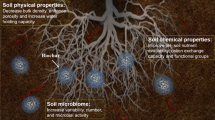Abstract
To date little or no nitrogen fixation has been found in composting materials. However, some materials have high C:N ratios and thus might be expected to support nitrogen fixation. We examined windrows of composting horse bedding and leaves for nitrogenase activity via acetylene reduction and used carbon monoxide controls to differentiate ethylene evolved by nitrogenase from that evolved by endogenous processes. In both piles temperatures were substantially elevated and partial pressures of oxygen greatly reduced thus indicating vigorous microbial activity. In the horse bedding, there were only low rates of ethylene evolution and little of this was due to nitrogen fixation. In contrast, much higher rates of ethylene evolution were measured in the leaf pile and 94% of this was due to nitrogenase activity. We estimate that the leaf pile fixed approximately 0.062 mg N/g leaves during a 5-week period.
Similar content being viewed by others
References
Barkmann J and Schwintzer C R 1998 Rapid N2 fixation in pines? Results of a Maine field study. Ecology 79, 1453–1457.
De Bertoldi M, Citernesi U and Griselli M 1980 Bulking agents in sludge composting. BioCycle 21, 32–41.
Diaz-Ravina M, Acea M J and Carballas T 1989 Microbiological characterization of four composted urban refuses. Biol. Wastes 30, 89–100.
Epstein E 1997 The Science of Composting. Technomic Publishing Company, Inc. Lancaster, PA, USA. 487 p.
Golueke C G 1972 Composting: A Study of the Process and its Principles. Rodale Press, Inc. Emmaus, PA, USA. 110 p.
Hendrickson O Q 1989 Implications of natural ethylene cycling processes for forest soil acetylene reduction assays. Can. J. Microbiol. 35, 713–718.
Nohrstedt H-Ö 1983 Natural formation of ethylene in forest soils and methods to correct results given by the acetylene-reduction assay. Soil Biol. Biochem. 15, 281–286.
Postgate J 1998 Nitrogen Fixation, 3rd Ed. Cambridge University Press, Cambridge, UK. 112 p.
Safwat M S A 1980 Composting cotton seed wastes. Compost Sci./Land Util. 21, 27–29.
Schwintzer C R and Tjepkema J D 1994 Factors affecting the acetylene to 15N2 conversion ratio in root nodules of Myrica gale L. Plant Physiol. 106, 1041–1047.
Silvester W B 1989 Molybdenum limitation of asymbiotic nitrogen fixation in forests of pacific northwest America. Soil Biol. Biochem. 21, 283–289.
Simpson F B and Burris R H 1984 A nitrogen pressure of 50 atmospheres does not prevent evolution of hydrogen by nitrogenase. Science 224, 1095–1097.
Sprent J I and Sprent P 1990 Nitrogen Fixing Organisms: Pure and Applied Aspects. Chapman and Hall, London, UK. 256 p.
Vitousek P M and Hobbie S 2000 Heterotrophic nitrogen fixation in decomposing litter: patterns and regulation. Ecology 81, 2366–2376.
Author information
Authors and Affiliations
Corresponding author
Rights and permissions
About this article
Cite this article
Schwintzer, C.R., Tjepkema, J.D. & Seekins, B. Nitrogenase activity in composting horse bedding and leaves. Plant and Soil 242, 277–282 (2002). https://doi.org/10.1023/A:1016254029856
Issue Date:
DOI: https://doi.org/10.1023/A:1016254029856




